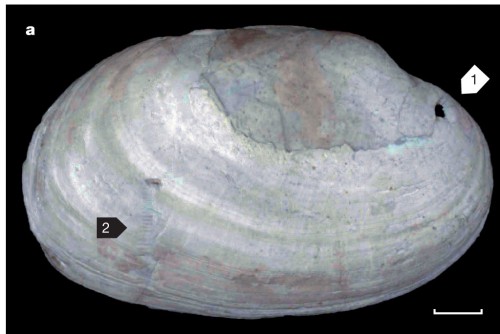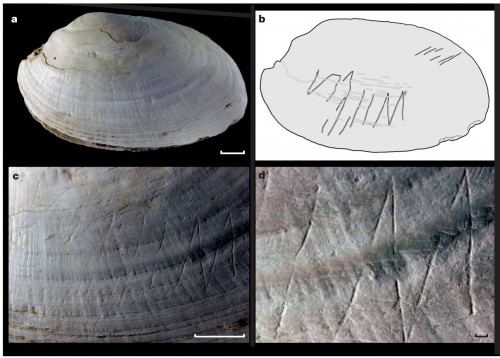Also, master of molluscan anatomy, and clever tool user. This paper, Homo erectus at Trinil on Java used shells for tool production and engraving, by Joordens et al. tells an interesting story from some mundane artifacts made half a million years ago.
What the investigators have is a jumble of clam shells, found in the strata where Homo erectus bones have been found elsewhere. These shells have been modified — the inference is that H. erectus was living along the shore, gathering clams, and popping them open to eat.
First, evidence of tool use. Many of them have small holes, precisely gouged into the shells at a specific location, and these holes do not resemble in detail the damage done by other mollusc-eating animals. The closest thing to the kind of damage done in these shells was made by using a shark tooth (common in the area), and twisting the point against the shell.
Second, they knew something about these molluscs. The holes were punched precisely above the attachment point for the adductor muscle, the big muscle that clams use to clamp their shells shut. Experimenting with modern clams, the authors found that one small hole above that attachment would damage the adductor, so the shell would easily open. Brilliant! Now I want to go dig some clams and try it myself.
And finally, doodler. One of the shells had some remarkable markings engraved on the inside — straight lines and a rough geometric pattern. The authors are quick to say there is no reason to justify calling this art, or something of religious significance, the two usual explanations trotted out for ancient paintings. I’m going to go out on a limb here, though, and suggest that our mighty clam hunter was doodling.
So after a delicious sea food dinner, H. erectus is relaxing, taking it easy, playing with the leftovers. And just to pass the time, she takes one of her handy shark teeth and scratches a mark on the shell — and then a few more. No big deal, she’s just a big ape exploring her environment with those dexterous, clever hands, and making idle doodles to entertain herself.
Who knows where this could lead?




I’ll go even farther out on a limb and suggest that since she clearly liked molluscs, liked expressing herself with scribbles, and because the evidence of the doodle clearly shows that her last name began with an “M”, she must have been an early Myers.
And now we all know that rq and pz are really the same person. The thing with the two letters as a name should have given it away, but look how gullible we were…..
Giliell
Well, I do have a Z in my real name…
Zach, is that you? I’ve always thought you wrote well, much as does our host. Have you ever been seen in the same room, together?
Homo erectus could not possibly have accomplished such remarkable feats at that time. They must have had assistance. I’m not saying it was aliens, but…
It was aliens.
Hey. My name starts with M, I have a shark tooth, and I have been to Java. So yeah, aliens.
Seriously, so clever a way to open a a clam. And that M does look designed.
JohnnieCanuck
No, I haven’t.
But PZ’s beard is fake, I can tell you that, since I am incapable of growing one at all!
(I’m an alien.)
I’m going to go out on a limb here and postulate that rq has been so deeply influenced by PZ that she is beginning to think and write like him, hence her earlier post in the Lounge.
Or, PZ has been so deeply influenced by the creative and intelligent writings of rq that he now effortlessly channels her thoughts.
rq @7
There’s a more parsimonious solution to your hirsute deficiency and it’s given in the OP. You’re not an alien, you’re a clam.
Al Dente
Clams have beards!!!
HIVEMIND!
The Singularity begins now!
Awww, YISSSS, finally!
Obviously not an M. Don’t believe the dogmatic fundamentalist scientismists who say such garbage. It’s clearly a Σ which the alien (whose last name happens to start with W, btw) used as part of a calculation for the trip back to their home planet. The map showing the trajectory is adjacent to it on the clam shell, including the needed discontinuous quantum leaps in spacetime.
Clearly it is also a Z. How did she find the clams if they weren’t pink?
Hah! The spot arrowed “2” in the picture appears to be a proto-barcode. The clam obviously came from and early Wal-Mart that saved on labor costs be using one mark for boys of their initials.
Don’t you folks know any archaeological reasoning at all?
I just think Homo erectus is funny.
I never was any good with the whole “maturity” thing.
It’s upside down and says Will W.
Wesley Crusher and time travel episodes have a lot to answer for.
rq @10
That’s what you clams want us to believe.
thought that was mussels.
byssus threads used for sessile attachment.
btw, there are some legit criticisms of this paper that weren’t touched on by PZ.
Coyne posted some of them when he ran the story.
excerpt:
the fact that the shells were of similar size can be explained by human choice, or by sorting in fast moving water.
it’s a legit criticism.
I tend to think their best work was with the bore holes in the shell, looking at microfracture lines that are nothing like what you would see if something like the radula of a snail or octopus made them.
that was pretty convincing to me.
0_o
…
How do we know that the hole was used to open the clam and not to make the shell into a necklace?
Clams can be opened by hitting them as well (some animals do that). However if it was a necklace or some other ornament it would explain why the hole (presumably there for a sinew or some other string) was on the opposite side of the carved surface.
If you look at the complete etching as shown in the sketch, it is clear that they were writing Y-U-M, which would make sense if they were doodling after a tasty clam dinner.
it’s a reasonable assumption given the location of the holes.
OTOH, if it was somehow discovered that the use of body jewelry actually existed at the time. the counter argument would be a tad stronger anyway.
messy. tends to get sand and pieces of shell over everything.
in the end, it’s actually faster to drill a hole.
that’s multiple, btw. there are lots of shells found with these holes in them, just in case that wasn’t clear.
If indeed the hole was drilled to open the clam, the inference is that these hominids had not yet started controlling fire. Cooking clams opens them right up. Did 500,000 year-old hominids have “buckets” to hold clams until they ejected their sand? Perhaps the drilling also caused the clams to eject sand.
Alexander Z @22… smashing clam shells leaves behind nasty detrius unpleasant to have in the mouth.
Was this before or after the Monolith taught these creatures to use bones as weapons, or, perhaps, as eating utensils for tasty clams?
Creationist quote mine in 3… 2… 1…
I see a sketchy octopus
perhaps
a self-portrait …
Ichthyic
Good point. Anyway, it’s a bit surprising that we don’t have evidence of ornaments or body jewelry from that period. If birds can pretty up their nests, why wouldn’t H. erectus do that to their bodies? Seems fairly odd. Fishy, even.
Kamaka #27
Unlikely. There are evidence that H. erectus used fire 0.5 million years ago, there are some evidence to even earlier periods (up to 1.7 million years ago – pdf) and many claim that the evolution of jaws, brain and stomach show fire use even earlier than that.
Sometimes people do things the way they do because that’s the way they’ve always done them. It might be that nobody up to that point had put the clams in hot water before opening them and noticed that they opened when that happened. Doesn’t preclude the use of fire for cooking or otherwise that they may have used a different method.
Technologies come and go. My point is this group of hominids drilling clams *may not* have had fire technology even though fire had long since been under control by other groups. Unlikely, but quite possible.
That said, these folks may well have preferred to eat their clams raw.
It would be very interesting that H. erectus did the doodling OR the drilling to eat the clams. I am mildly amused that the zig-zag lines are similar to the first doodles attributed to H. sapiens in a cave site in South Africa. Those are about 80,000 years old, if I recall .
No, clams got legs.
If it’s mussels with beards (couldn’t remember the word last night), then maybe I am a clam. This deserves some self-reflection.
singulwhat?
clams got legs?
aaaaaaaahhh
Clearly the “doodle” is a scale representation of islands and submarine topography as seen horizontally.
I clearly see “J H N” An abbreviation for Johansson!
Or….”Jesus the Hebrew from Nazareth” (he showed up too early again, just like with the dinosaurs*)
H. Erectus watched Jesus appear, only to get trampled by a herd of Hipparion. This is the earliest known Bible fragment!
*it’s true. Ask Eddie Izzard.
Eddie Izzard and I aren’t speaking, not after that incident with the champagne cork and the bit of string.
The shell has an M on it. Was someone ostracised? Was M voted off the island?
Hunh. I am constantly doodling hash lines like this: ////// then I do the opposite \\\\\ to make a grid. Nice to know this is an impulse that’s very, very old.
The original ancestor of Fabergé ?
H. erectus? Shoreline? Shellfish?
I’m surprised the Aquatic Ape dudes haven’t shown up yet.
But hey now, we haven’t ruled out genetically-enhanced-by-aliens-super intelligent-sharks-with-power-drills yet have we?
These are shells of unionids, commonly known as freshwater mussels. Anyone who wants to experiment with this clam-opening technique in the U.S. should learn to ID the common ones first. They’re at their most diverse here with nearly 300 species, and a ridiculous percentage of them are endangered. If you just want to doodle, it’s often easy to find the shells along the edges of streams and rivers.
Damned Yithians never did clean up after themselves properly.
“Who knows where this could lead?” Velvet Elvis.
Marc Verhaegen himself showed up on the Scientific American version of this.
Frigging lasers on their heads.
How about:
Young H. erectus is collecting food with a more experienced companion – asks how to open the damn thing – gets handed a shark tooth – makes some ineffective scratches before being shown the correct procedure.
But otherwise, obviously religious significance.